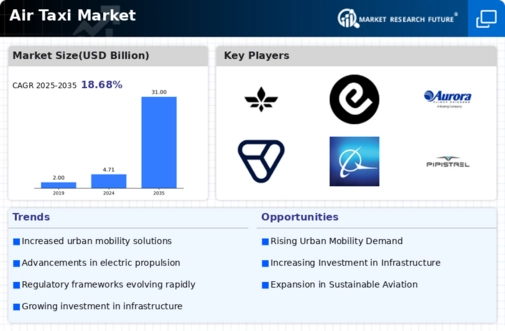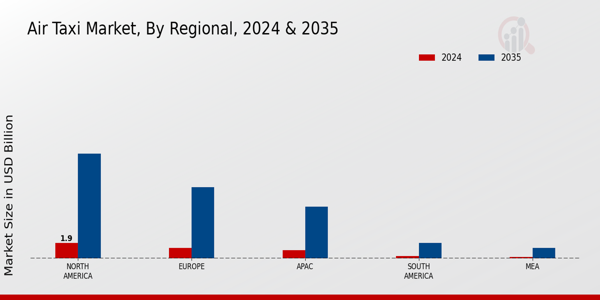Market Growth Projections
The Global Air Taxi Market Industry is poised for remarkable growth, with projections indicating a substantial increase in market size. The market is expected to expand from 4.71 USD Billion in 2024 to an impressive 31 USD Billion by 2035. This growth trajectory suggests a robust compound annual growth rate (CAGR) of 18.68% from 2025 to 2035. Such projections underscore the increasing interest and investment in air taxi services, driven by technological advancements, urbanization, and changing consumer preferences. The anticipated growth reflects a broader trend towards innovative transportation solutions that address urban mobility challenges.
Technological Advancements
The Global Air Taxi Market Industry is experiencing rapid technological advancements that enhance the feasibility and safety of air taxis. Innovations in electric vertical takeoff and landing (eVTOL) aircraft are at the forefront, enabling urban air mobility solutions. For instance, companies are developing autonomous flight systems that could reduce operational costs and improve efficiency. The integration of advanced navigation systems and AI-driven traffic management may further streamline urban air travel. As a result, the market is projected to grow from 4.71 USD Billion in 2024 to an estimated 31 USD Billion by 2035, reflecting a compound annual growth rate (CAGR) of 18.68% from 2025 to 2035.
Urbanization and Congestion
The Global Air Taxi Market Industry is significantly influenced by increasing urbanization and traffic congestion in metropolitan areas. As cities expand, traditional ground transportation systems struggle to accommodate rising populations, leading to longer commute times. Air taxis present a viable alternative, offering rapid transit solutions that bypass ground traffic. For example, cities like Los Angeles and Singapore are exploring air taxi services to alleviate congestion. This trend is likely to drive demand for air taxi services, contributing to the market's anticipated growth from 4.71 USD Billion in 2024 to 31 USD Billion by 2035, with a CAGR of 18.68% from 2025 to 2035.
Environmental Sustainability
The Global Air Taxi Market Industry is increasingly driven by the demand for environmentally sustainable transportation solutions. As concerns over climate change intensify, air taxis, particularly those powered by electric propulsion, offer a cleaner alternative to traditional aviation. The shift towards sustainable urban mobility is evident in initiatives aimed at reducing carbon emissions. For example, several air taxi manufacturers are focusing on developing eVTOL aircraft that utilize renewable energy sources. This growing emphasis on sustainability is expected to attract investment and consumer interest, contributing to the market's growth from 4.71 USD Billion in 2024 to 31 USD Billion by 2035, with a CAGR of 18.68% from 2025 to 2035.
Consumer Demand for Convenience
The Global Air Taxi Market Industry is also propelled by a rising consumer demand for convenience and time efficiency in transportation. As urban populations grow, individuals seek faster and more reliable travel options. Air taxis provide a unique solution by offering direct routes and reduced travel times compared to traditional ground transportation. This demand is particularly pronounced among business travelers and affluent consumers who prioritize time savings. The increasing willingness to pay for premium services may further stimulate market growth, with projections indicating an expansion from 4.71 USD Billion in 2024 to 31 USD Billion by 2035, reflecting a CAGR of 18.68% from 2025 to 2035.
Government Initiatives and Regulations
Government initiatives and regulatory frameworks are pivotal in shaping the Global Air Taxi Market Industry. Various countries are actively promoting urban air mobility through supportive policies and funding. For instance, the Federal Aviation Administration in the United States is developing regulations for eVTOL aircraft operations, which may facilitate the safe integration of air taxis into existing airspace. Additionally, governments are investing in infrastructure to support air taxi operations, such as vertiports. These efforts are likely to bolster market growth, with projections indicating an increase from 4.71 USD Billion in 2024 to 31 USD Billion by 2035, representing a CAGR of 18.68% from 2025 to 2035.





















